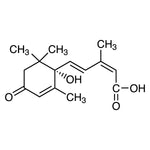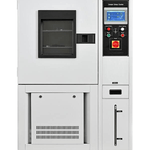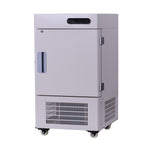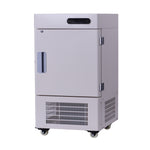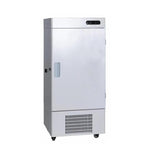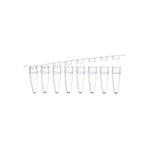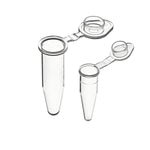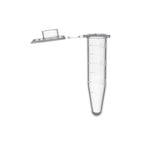You have no items in your shopping cart.
Cryovials are tubes made from autoclavable polypropylene material. All polyethylene, including polypropylene, are characterized as polyolefin, a compact-molecular hydrocarbon. Its chemical makeup is the same as polyethylene; however, every unit contains a methyl group attached to it. Its chemical composition enables it to be non-contaminating, lighter than H2O, and non-toxic.
The abovementioned traits are why polyethylene is the best material for making cryovials. Cryovials are designed to store biological material at shallow temperatures of about -196 ºC, which Liquid Nitrogen achieves in gas form.
Most materials will break down at such low temperatures, which is why polythene is the best material to use. Cryovials contain white marking prints for identification. The tubes and caps have a similar expansion coefficient, making them leakproof at varying temperatures.
The caps are also made from polyethylene with one added modification: a silicone O-ring that ensures leakproof qualities. You can fit color codes on the lids for further identification. For a cryovial to be of standard quality, it must be certified DNAse, RNAse, and pyrogen-free. Before cryovials can be launched, they are sterilized by gamma irradiation, after which they are packed in safety-lock packages containing a hundred vials per bag.
Benefits of Using Cryovials
The benefits of using cryovials compared to other forms of packaging are boundless, but here are some of the bests you should consider.
Vials are certified.
Each vial is certified to ensure it's free of all contaminants. Therefore, you are assured that your experiments or samples won't get contaminated. Certified vails are proof that the cryovials you purchase are all up to code according to the policies set by SAL 10-6.
Superior Quality
Quality is a standard that everybody wants in any product they purchase. Authentic cryovials are made from raw medical-grade materials. They are free of cytotoxins, mutagens, heavy metals, BTSE/TSE including other contaminants.
They are manufactured and assembled in clean, sterilized rooms and packaged in tamper-proof packages.
Automation-ready
They feature slim profile design caps, which enhance a more excellent fit into racks (star sockets made for automated capping or decapping). Each barcode imprinted on each vial makes it easy for automatic data collection.
User-friendly
Cryovials are user-friendly with white surfaces for writing and easy identification of different samples. Imprinted graduations allow for easier and more accurate measurements.
Difference between External and Internal Threads
There is a lot to consider when searching for the best cryovial. Apart from volume and brand, you need to consider the best fit. Selecting between internal or external threads is more than just personal preference or taste.
A cap with an outer thread might cause the cryovial caps to knock into each other and not fit perfectly. External thread caps present a tighter fit, but they have a slightly larger design than internal thread caps.
What to Avoid When Using Cryovials
Cryovials are primarily used in storing biological material in cryogenic conditions by using liquid nitrogen at its gaseous state. When removing vials with samples from low temperatures, liquid nitrogen might seep in, causing the vial to expand as it converts from its liquid form to a gaseous state. If not handled carefully, the cryovial can explode due to rapid expansion and contraction caused by the difference in temperature.
Once nitrogen seeps in, it creates a colder internal temperature compared to the external temperature of the room. The sudden change in temperature causes the tube to expand and contract rapidly, which causes the tube to explode.
An exploding vial might lead to unprecedented injuries and exposure to contents in the vial. Also, cross-contamination of contents or cells can occur, sabotaging your experiments. Ensure you tightly seal the cap after introducing your samples into the cryovials. Store the vials in tamper-proof racks to avoid breakage.
In April 2020, many reports of cryovial explosions, which, unfortunately, led to injuries, were reported. Later it was discovered that most research facilities used female caps, which has been proven to be part of the problem. After thorough investigations were done, manufacturers and other members came up with solutions that might hinder the occurrence from happening again, and here they are:
Here are some of the corrective measures you can apply to avoid Cryovial explosions
-
Switching from cryovials containing internal threads with female caps to ones with male caps (currently, there are no reports of explosions from the use of male caps).
-
Ensure you follow cryovial manufacturers’ instructions, stating that both external and internal thread vials shouldn't be immersed in liquid nitrogen to avoid explosion risks.
-
Avoid storing vials containing biohazard in storages using liquid nitrogen instead of storing them in storages with liquid nitrogen in a gas state.
-
Use special Cryoflex vials if the content of the vials requires to be immersed in liquid nitrogen for preservation or any other heat seals to avoid liquid nitrogen from seeping into the vial.
-
When using cryovials exposed to liquid nitrogen, immediately put the vial in an unbreakable and properly sealed plastic contained before thawing. This would help contain an explosion if any liquid nitrogen seeped in. You can also choose to transfer the vials from the liquid form to a gaseous state which takes about 24 hours to allow thawing without the risk of explosion properly.
What separates cryovials from other types of vials?
Below are notable features that make cryogenic vials the best equipment for biological material preservation.
100 % Sterile
For cryovials to achieve the contaminant-free status, they are sterilized through a process that complies with SAL 10-6 standards set by DIN EN ISO11137. All vials have more than a five-year sterility period.
In addition to their sterile nature, they are stored in a contaminant-free cryopreservation package, free of detectable heavy metal. Furthermore, each cryovial is quality checked for BSE/TSE, detectable RNases, DNase, and cytotoxins, among others. Using a cryogenic vial means your samples are insured against packaging-induced contaminants.
Leak-proof
One unique feature cryovials possess is an outer thread design that decreases the chance of leakage without increasing the bulkiness of the cryovial. Half a turn is all it takes to seal the leap, granting full leak-proof qualities.
Durability
It's created from a unique propylene material with a wide pressure range of about 95kPa/0.95bar.The material design is long-lasting and can withstand severe temperature pressure and energy conditions.
Conclusion
Conducting experiments on biomaterials, chemicals, and other substances requires various lab equipment, which are on sale at Biofargo. A cryovial is must-have equipment in every lab; its effective use ensures that you get to store your contents safely and free from contaminants.

